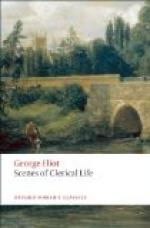dimly conjectured. Perhaps Milby was one of the
last spots to be reached by the wave of a new movement
and it was only now, when the tide was just on the
turn, that the limpets there got a sprinkling.
Mr. Tryan was the first Evangelical clergyman who
had risen above the Milby horizon: hitherto that
obnoxious adjective had been unknown to the townspeople
of any gentility; and there were even many Dissenters
who considered ‘evangelical’ simply a sort
of baptismal name to the magazine which circulated
among the congregation of Salem Chapel. But now,
at length, the disease had been imported, when the
parishioners were expecting it as little as the innocent
Red Indians expected smallpox. As long as Mr.
Tryan’s hearers were confined to Paddiford Common—which,
by the by, was hardly recognizable as a common at
all, but was a dismal district where you heard the
rattle of the handloom, and breathed the smoke of
coal-pits—the ‘canting parson’
could be treated as a joke. Not so when a number
of single ladies in the town appeared to be infected,
and even one or two men of substantial property, with
old Mr. Landor, the banker, at their head, seemed to
be ‘giving in’ to the new movement—when
Mr. Tryan was known to be well received in several
good houses, where he was in the habit of finishing
the evening with exhortation and prayer. Evangelicalism
was no longer a nuisance existing merely in by-corners,
which any well-clad person could avoid; it was invading
the very drawing-rooms, mingling itself with the comfortable
fumes of port-wine and brandy, threatening to deaden
with its murky breath all the splendour of the ostrich
feathers, and to stifle Milby ingenuousness, not pretending
to be better than its neighbours, with a cloud of
cant and lugubrious hypocrisy. The alarm reached
its climax when it was reported that Mr. Tryan was
endeavouring to obtain authority from Mr. Prendergast,
the non-resident rector, to establish a Sunday evening
lecture in the parish church, on the ground that old
Mr. Crewe did not preach the Gospel.
It now first appeared how surprisingly high a value
Milby in general set on the ministrations of Mr. Crewe;
how convinced it was that Mr. Crewe was the model
of a parish priest, and his sermons the soundest and
most edifying that had ever remained unheard by a
church-going population. All allusions to his
brown wig were suppressed, and by a rhetorical figure
his name was associated with venerable grey hairs;
the attempted intrusion of Mr. Tryan was an insult
to a man deep in years and learning; moreover, it
was an insolent effort to thrust himself forward in
a parish where he was clearly distasteful to the superior
portion of its inhabitants. The town was divided
into two zealous parties, the Tryanites and anti-Tryanites;
and by the exertions of the eloquent Dempster, the
anti-Tryanite virulence was soon developed into an
organized opposition. A protest against the meditated
evening lecture was framed by that orthodox attorney,




